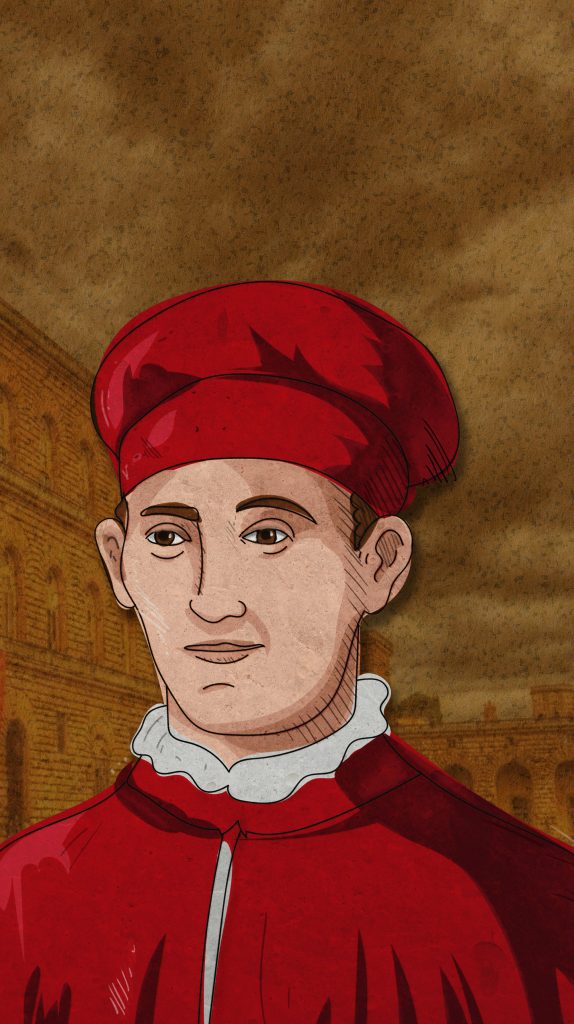One member of the Medici dynasty would be the making of Luca Pitti (1398-1472) while another would be his downfall, but the huge building with its famous Boboli Gardens and piazza not far from the Ponte Vecchio that still bear his name are testimony to the standing he commanded within the Florentine Republic. Born into a wealthy merchant family originally from Semifonte Castle on the road to Siena, Luca Pitti inherited his father Buonaccorso’s ambition and drive. Appointed as Gonfalonier of Justice, or chief justice, Luca acquired monetary gain, influence and power with the help of Cosimo di Giovanni de’ Medici (1389-1464) and, in August 1458, he took control of the Florentine government, engineering a coup on behalf of the old and failing Cosimo.

In 1440, Luca decided to build a residence in Florence on hillside land after demolishing the old houses there, which he had purchased in the “Bogole” area in 1418. (His other project involved restoring a country villa in Rusciano, south of the city.) The Florentine palace would dominate what went on to become the sloping piazza in front of it. It was to be a bigger and better edifice than those owned by the Medici or the Strozzi, another rival family of his. In fact, legend has it that Luca wanted the windows to be larger than the doors of the Medici home in via Largo (today’s via Cavour) and the courtyard to be ample enough to encompass the entire Palazzo Strozzi in Porta a San Pancrazio (today’s via de’ Tornabuoni). The massive scale of Luca’s palace would make it the largest private home in the world at that time, featuring a facade that was 36 metres high and 55 metres wide with enormous blocks of stone having been pulled up to the site to erect the cornice. It was to be tangible evidence for all to see of the eminence of its owner.
Although disputed by some historians, Vasari claimed that the original plans for the palace were drawn up by Filippo Brunelleschi, who died in 1446, before work began on the building. The project was subsequently entrusted to one of his assistants, Luca Fancelli (1430-95). Despite its vastness, however, the internal spaces were designed to protect the family’s privacy, for example, by the height of the windows.
Disaster struck for Luca after the death of Cosimo in 1464 when he joined a conspiracy to rid Florence of Cosimo’s son, Piero di Cosimo de’ Medici, known as Piero the Gouty, whom he and his fellow conspirators thought had usurped power and was inept. Planning to ambush Piero on his way to his villa in Careggi, his son Lorenzo (who would later become “the Magnificent”) discovered the roadblock set up to entrap his father, enabling Piero to escape by changing his route. Although Piero refused to sign the death warrants of his enemies, he was not slow to take his revenge by ruining Luca Pitti financially. (Luca owed the Medici bank large sums of money that had accumulated over the years.) Work on the palace stopped in 1465 and Luca would die in 1472, never to see his dream come true. The Pitti family continued to live there until 1549, when a descendant of Luca, another Buonaccorso, sold it to Cosimo I de’ Medici’s wealthy Spanish wife, Eleanor of Toledo, for 9,000 florins. At the time, the palace had only one floor and no roof, but it was still an impressive building. The generous gardens and citrus orchards meant it was perfect for the large ducal family after improvements had been carried out by the finest artists and artisans of the day. Architect Bartolomeo Ammannati, whose wife Laura Battiferri was a close friend of Eleanor, was entrusted with the renovations. Between 1560 and 1577, he redesigned the ground-floor windows on the facade and the family’s apartments, in addition to completing the impressive courtyard with the ashlar steps incorporated within the amphitheatre by Tribolo. The palace was no longer simply a family home; now it had become a seat of representation of the city’s rulers.
In 1620, Giulio Parigi, a Florentine architect who had trained under Bernardo Buontalenti, extended the facade of the Pitti Palace and made considerable additions to the Boboli Gardens. Upon his death, Parigi’s son Alfonso, also an architect, further enlarged the ground and first floors until the building took on the appearance we know today. He also continued work on the garden.
With the death of the last Medici heir in 1737, the palace passed to the Lorraine-Hapsburg grand dukes of Tuscany, who added new wings and embellishments. In 1796, Napoleon Bonaparte was received at the Pitti Palace by Grand Duke Ferdinand III in the Sala Bianca and the adjacent Sala di Bona. Lunch was served in the Sala dei Nicchie overlooking the piazza, as it would be again in 1938, when the Savoys entertained Adolf Hitler on his first visit to Florence.
In 1865, the palace became the reluctant residence of Vittorio Emanuele II, King of Italy, when Florence was the nation’s capital for a brief spell. In 1919, King Vittorio Emanuele III donated the Pitti Palace to the Italian State and the monument was turned into a museum, including the vast collection of artworks and historic artifacts. In 1944, during World War II, the palace was badly damaged, but was still used as a refuge for many Florentines, especially after the city was torn in two after the Germans blew up the bridges during their retreat in August that year. It was later restored.
Today, the palace is the city’s largest museum complex, housing the Palatine Gallery, the Royal Apartments, the Museum of Fashion and Costume, the Museum of Modern Art and the Silver Museum. In 2017, the Pitti Palace celebrated its 500th anniversary. May it stand for another 500 years and many more besides!







